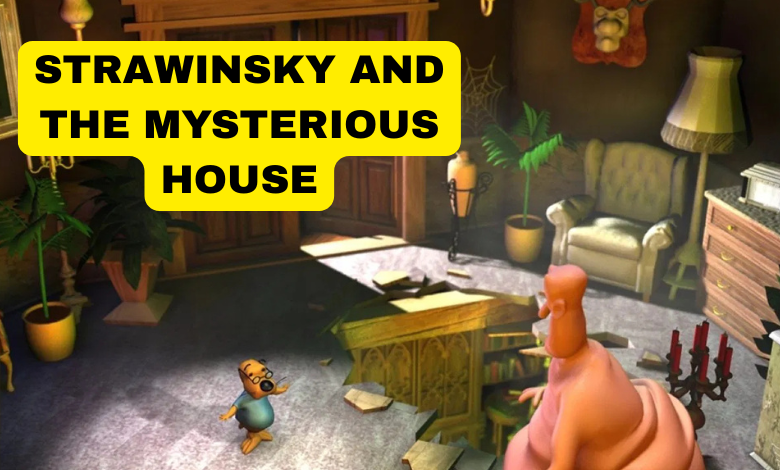Strawinsky and the Mysterious House: A Forgotten Christian Game With Lasting Lessons

When people think of classic video games, titles like Mario, Zelda, or Sonic often come to mind. But for some of us who grew up in Christian households during the 1990s and early 2000s, there was another title that stood out: Strawinsky and the Mysterious House. It wasn’t just another adventure game. It carried lessons about morality, choices, and faith, wrapped in a unique animated world. While it may not be as widely known as mainstream titles, the game holds a special place in the hearts of those who experienced it.
In this article, I want to dive deep into what made Strawinsky and the Mysterious House unique. We’ll explore its story, gameplay, Christian symbolism, and lasting impact on players. I’ll also share personal reflections and explain why this game, even though relatively obscure, still matters today.
The Origin of Strawinsky and the Mysterious House
Strawinsky and the Mysterious House was not created by one of the gaming giants. Instead, it came from a niche within Christian multimedia companies that were experimenting with video games as a way to reach younger audiences. During the late 90s and early 2000s, there was a push to create faith-based entertainment that could compete with mainstream content. This is the context in which Strawinsky was born.
The game combined elements of storytelling, puzzles, and exploration with a Christian worldview. It wasn’t about fighting or shooting. Instead, it placed the player in a world where choices mattered, where every decision had moral implications. For many families, it was refreshing to see a game that parents could feel safe letting their children play.
Story and Gameplay Explained
The story revolves around Strawinsky, the main character, who finds himself in a mysterious house filled with secrets and strange encounters. The house is not just a physical place but a metaphor for life’s challenges. Players must guide Strawinsky through different rooms, solve puzzles, and interact with characters who represent various moral choices.
The gameplay itself was simple by today’s standards, but it had a charm. Instead of fast-paced action, it leaned on exploration and dialogue. Players had to pay attention to details, read between the lines, and sometimes reflect on biblical themes woven into the narrative.
I remember playing it as a kid and being surprised at how much it felt like a storybook come to life. Unlike other games, it wasn’t about “winning” in the traditional sense. It was about learning—about trust, about right and wrong, and about the consequences of choices.
Read Also: Understanding Centiva Capital: What It Is, How It Works, And Why It Matters
Characters That Drive the Adventure
One of the strengths of Strawinsky and the Mysterious House was its characters. Each one was designed not only to add depth to the story but also to represent ideas and moral lessons.
-
Strawinsky: The curious protagonist, representing innocence and the search for truth.
-
The Housekeeper: A guiding figure who helps Strawinsky understand the meaning of the house.
-
Various Residents: Each character Strawinsky meets offers a challenge, temptation, or lesson.
Through these interactions, the game gently guided players toward reflection. It wasn’t preachy in the way some faith-based content can be, but it was deliberate in weaving Christian symbolism into character design.
Christian Themes and Educational Value
At its heart, Strawinsky and the Mysterious House was a Christian educational game. It drew inspiration from parables and biblical storytelling. The house itself often felt like a modern allegory for life’s journey.
Some of the lessons included:
-
The importance of discernment.
-
The value of faith and trust in God.
-
The dangers of selfish choices.
-
The power of forgiveness.
For children, these themes were presented in a way that was approachable. The visuals, dialogue, and pacing made it accessible even to younger audiences. Looking back, I see how cleverly it combined fun with moral learning.
Reception Over the Years
When it was released, Strawinsky and the Mysterious House didn’t make headlines like mainstream titles. Reviews from Christian families and niche communities were generally positive, though. Parents appreciated that it was safe, thoughtful, and values-driven.
Today, the game is more of a hidden gem. Some people stumble across it while exploring retro Christian media, while others fondly remember it from their childhood. Nostalgia plays a huge role in its modern reception, as many now look back and realize how unique it was for its time.
The Nostalgia Factor
If you played this game as a kid, chances are you remember it vividly. The mysterious atmosphere, the slightly quirky characters, and the sense of discovery made it memorable. Nostalgia adds another layer of appreciation.
Personally, I remember sitting at an old desktop computer, probably running Windows 98, carefully clicking through the rooms of the house. Even though the graphics were simple, it felt immersive. It’s funny how games like this, though not technically advanced, could leave such a strong impression.
Comparison With Other Christian Games
Strawinsky and the Mysterious House wasn’t alone in trying to blend faith and gameplay. Other titles like Bible Adventures or The You Testament also explored similar territory. However, Strawinsky stood out because it wasn’t trying to be action-packed. Instead, it leaned into storytelling and allegory.
This made it unique. While Bible Adventures, for example, was more of a platformer, Strawinsky felt more like an interactive parable. That distinction made it resonate differently with players.
Why It Still Matters Today
So why talk about Strawinsky and the Mysterious House in 2025? The truth is, even though gaming technology has advanced dramatically, the principles behind Strawinsky remain relevant. Parents still look for wholesome, meaningful games for their children. Developers still wrestle with how to weave moral or educational lessons into entertainment without making it boring.
Strawinsky serves as an early example of how it can be done. It reminds us that games don’t always have to be about winning battles. They can also be about growing, reflecting, and learning.
Where to Find and Play the Game
Finding Strawinsky and the Mysterious House today can be tricky. It was never a blockbuster title, so copies are rare. Some players share old disks, while others turn to community forums dedicated to Christian media. In some cases, fans have even created walkthroughs and guides online to preserve the experience.
If you’re looking for something similar today, there are also modern Christian games available on PC and mobile that follow the same spirit of teaching values. While technology has improved, the heart behind games like Strawinsky lives on.
Personal Reflections and Takeaways
Looking back, I can say that Strawinsky and the Mysterious House taught me something that many mainstream games at the time didn’t. It showed me that games could be more than just entertainment. They could be stories that made you think about life, faith, and the choices you make.
Even now, as an adult, I appreciate that early exposure. It’s a reminder that the media we consume as children often shapes the way we see the world. That’s why Strawinsky remains more than just an old game—it’s a memory, a lesson, and a piece of history worth remembering.
Conclusion
Strawinsky and the Mysterious House may not be a household name, but for those who played it, it was unforgettable. It blended faith, storytelling, and gameplay in a way that was simple yet meaningful. It reminded us that choices matter, that stories can teach, and that games can reflect deeper truths.
In today’s fast-paced world of flashy graphics and endless action, Strawinsky feels like a quiet, thoughtful relic from another time. But maybe that’s exactly why it’s worth revisiting. It shows us that even a small, faith-based game can leave a lasting mark.
FAQs
Q: What is Strawinsky and the Mysterious House about?
It’s a Christian adventure game where players guide the character Strawinsky through a mysterious house filled with moral choices and biblical symbolism.
Q: Is Strawinsky and the Mysterious House still available?
It’s rare to find, but some copies exist in Christian media collections or online fan communities.
Q: Who is Strawinsky?
Strawinsky is the main character of the game, representing innocence and the search for truth.
Q: What age group is the game suitable for?
It was designed for children and families, but adults interested in Christian-themed games may enjoy it too.
Q: How is it different from other Christian games?
Unlike action-oriented Christian games, Strawinsky focused more on storytelling, allegory, and moral lessons.



